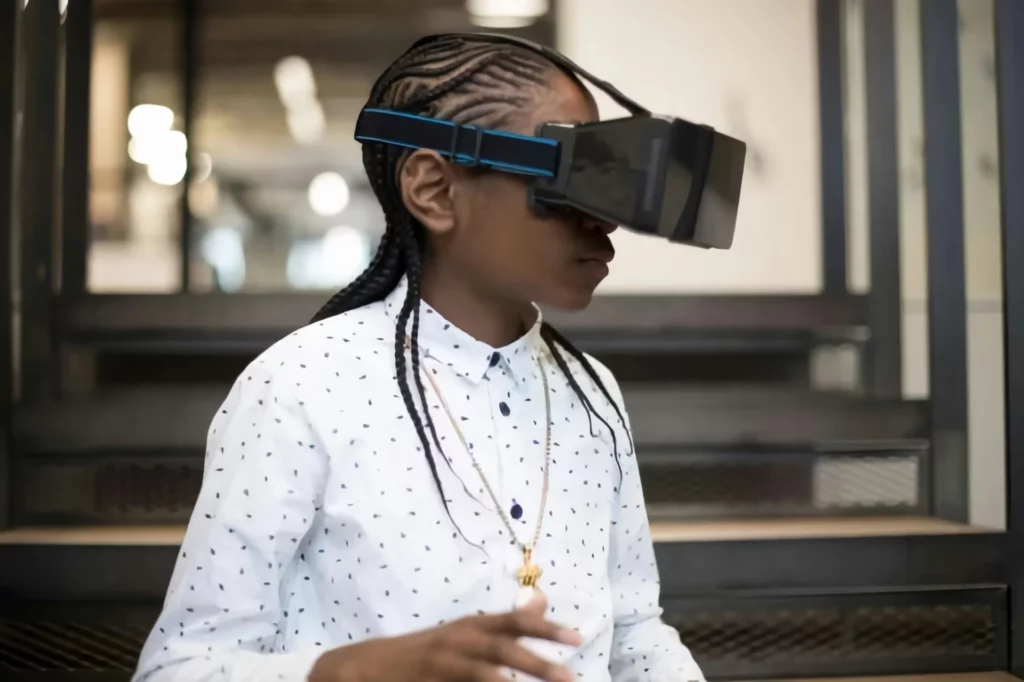The combination of virtual reality (VR), augmented reality (AR), the internet, and other immersive technologies has produced the Metaverse, a communal virtual shared area. It is envisioned as a persistent, immersive virtual world where users, independent of physical location, can engage in real-time interaction with digital things and each other.
Users can engage in a variety of activities in the Metaverse, including gaming, entertainment, socializing, business, education, and more. By providing a smooth and immersive atmosphere that dissolves the distinctions between the digital and real worlds, it surpasses conventional online encounters.

Characteristics of the Metaverse
Key characteristics of the Metaverse include:
- Persistent and Immersive: The Metaverse is persistent, meaning it exists continuously and evolves over time. It offers immersive experiences that engage multiple senses, often through VR headsets, AR glasses, or other immersive devices.
- Interconnected Virtual Worlds: The Metaverse consists of interconnected virtual worlds or environments, each with its own rules, economies, and communities. Users can seamlessly navigate between these worlds and interact with others across platforms and experiences.
- User-generated Content: Users play a central role in shaping the Metaverse through the creation and sharing of content. This includes designing virtual spaces, developing digital assets, programming interactive experiences, and more.
- Economy and Commerce: The Metaverse supports virtual economies where users can buy, sell, and trade digital goods and services. This includes virtual real estate, in-game assets, digital collectibles (NFTs), virtual currency, and more.
- Social Interaction and Collaboration: Socialization is a core aspect of the Metaverse, allowing users to connect, communicate, and collaborate with others in virtual environments. This includes everything from casual hangouts and events to virtual meetings and conferences.
- Cross-platform Accessibility: The Metaverse is accessible across various devices and platforms, including PCs, consoles, mobile devices, VR headsets, and AR glasses. This enables a wide range of users to participate in immersive experiences regardless of their hardware.
Web3 role in Metaverse
Web3 is expected to play a significant role in the development and operation of the Metaverse, particularly in terms of enabling decentralized, interoperable, and user-owned virtual experiences. Here are some key ways in which Web3 technologies are poised to impact the Metaverse:
- Decentralization: Web3 leverages blockchain technology and decentralized protocols to enable trustless interactions and ownership of digital assets. In the Metaverse, this means that users can have true ownership of their virtual belongings, such as digital land, avatars, or in-game items, without relying on centralized platforms or authorities. Decentralization also ensures greater resilience and censorship resistance within the Metaverse ecosystem.
- Interoperability: Web3 standards and protocols promote interoperability between different virtual worlds, platforms, and experiences within the Metaverse. This allows users to seamlessly navigate between diverse virtual environments, bringing their digital identities, assets, and preferences with them across platforms. Interoperability fosters a more open and interconnected Metaverse ecosystem, encouraging collaboration and innovation among developers and users.
- Tokenization and Digital Economy: Web3 enables the tokenization of digital assets and the creation of programmable tokens on blockchain networks. In the Metaverse, this facilitates the emergence of vibrant virtual economies where users can buy, sell, trade, and monetize digital goods and services. Non-Fungible Tokens (NFTs) play a particularly significant role in representing unique, verifiable ownership of virtual assets such as digital art, virtual real estate, or in-game items.
- Decentralized Identity and Reputation: Web3 supports the development of decentralized identity solutions that enable users to control and manage their digital identities across different virtual environments. This enhances privacy, security, and user autonomy within the Metaverse by reducing reliance on centralized identity providers. Decentralized reputation systems also enable users to establish trust and credibility based on their interactions and contributions within the Metaverse.
- Community Governance and Participation: Web3 introduces decentralized governance mechanisms such as Decentralized Autonomous Organizations (DAOs) that enable community-driven decision-making and resource allocation within the Metaverse. DAOs allow users to collectively govern virtual worlds, platforms, and protocols, ensuring transparency, inclusivity, and alignment of incentives among stakeholders.
- Immutable Records and Provenance: Web3’s use of blockchain technology provides immutable records and provenance for virtual assets and transactions within the Metaverse. This enhances transparency, authenticity, and traceability, reducing the risk of fraud, counterfeiting, or disputes related to virtual ownership and transactions.
Conclusion
A vision of the next generation of the internet, known as the Metaverse, allows users to live, work, play, and socialize in virtual worlds where the only boundaries are their imagination and available technology. It affects social interaction, business, education, entertainment, and a host of other societal facets.
And Web3 technologies are poised to transform the Metaverse by empowering users with greater ownership, interoperability, privacy, and governance over their virtual experiences and assets. They lay the foundation for a more decentralized, inclusive, and user-centric Metaverse ecosystem that reflects the principles of Web3.